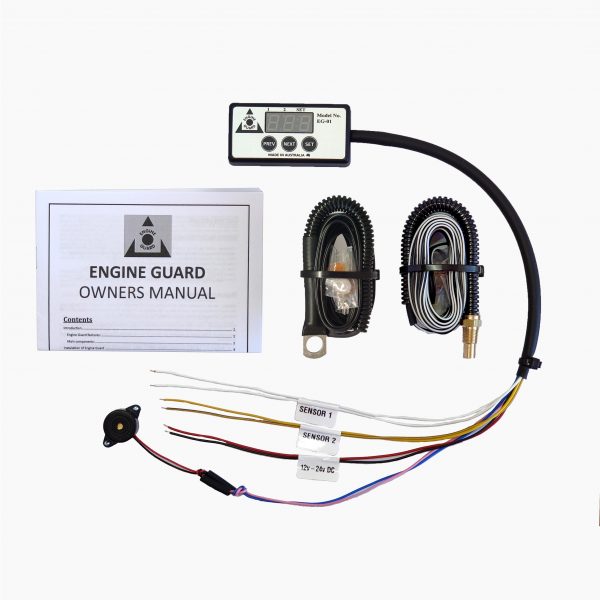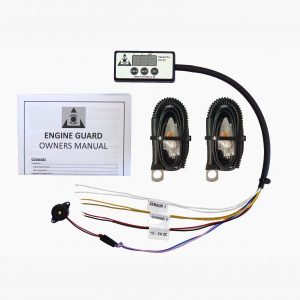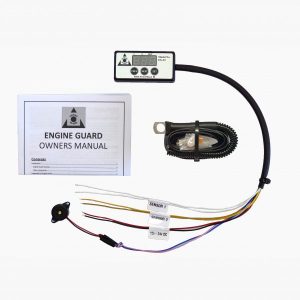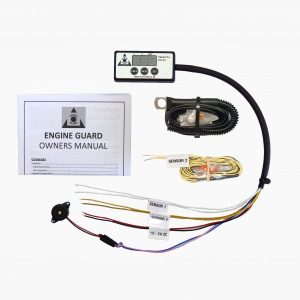ENGINE GUARD EG01-6
1 x BOLT-ON Temperature Sensor (input 1) and 1 x SCREW-IN Brass Temperature Sensor (input 2)
£109.99
Dual Temperature Sensor Kit – 1 x bolt-on & 1 x screw-in sensor
Includes:
- 1 x Digital Display Unit
- 1 x Bolt-on Temperature Sensors with 5m cable
- 1 x Screw-in 1/8th NPT threaded brass coolant sensor
- Wiring loom, water-resistant connectors
- Owner’s Manual
- The kit is supplied in a transparent retail package with hanger hole at the top, barcoded.
Product Description
Dual Temperature Sensor System – 1 x bolt-on type sensor AND 1 x brass 1/8th NPT screw-in type sensor
This system gives you the ability to monitor 2 locations at the same time- 1 x sensor on the head PLUS 1 x for the coolant temperature. For example:
- Cylinder head: The bolt-on sensor is quickly and easily installed – just like a washer under the head of a bolt on the cylinder head! For example, the lifting bracket bolts commonly found on the cylinder head are ideal. Otherwise, just use a bolt on the inlet side of the head or even add a short bolt into an unused threaded hole in the head casting
- Coolant temperature: The brass screw-in type sensor is intended for monitoring inline coolant temperature. They are commonly installed in 2 different ways: the simplest method utilizes a pre-drilled port that threads into the radiator. These are commonly found on after-market radiators and on some factory cooling systems. These ports are frequently plugged by manufacturer’s- you can just remove the original plug, apply sealant, and screw-in the new sensor. Alternatively, radiator hose adaptors are commonly available at auto accessory shops and online. These feature a 1/8th NPT threaded hole where the new sensor can be located. The adaptors are installed by cutting a short section out of the top radiator hose, and the adaptor is installed like a joiner with 2 x hose clamps on the splined inlet and outlet. The allows monitoring of the coolant as it circulates around the cooling system.
NOTE: The screw-in type temperature sensor requires direct contact with the coolant. We advise that this type of sensor is suitable for more experienced installers. Care must be taken to avoid leaks. Please seek advice from a suitably qualified expert if you are unsure how to install this type of sensor.
The Display shows temperature on sensor 1 as the default, but the operator can change between 1 and 2 at any time. In addition, if either sensor reaches the alarm set point and the alarm is triggered, the Display shows WHICH sensor (No.1 or No.2) and the real time temperature is displayed. In addition, on start-up, the Display shows both alarm set-points in sequence.
How does ENGINE GUARD work?
The ENGINE GUARD system is an advanced digital temperature gauge with a user-adjustable audible alarm. Designed to warn you of overheating, the system will also provide very accurate real time monitoring of changes in temperature. Many owners report that they are surprised to see significant variations in engine temperature- whereas the factory temperature gauge hardly moves. This is because most factory temperature gauges only show LARGE temperature changes- typically in three stages being ‘COLD – OK – OVERHEATING’. But actual engine temperatures can change between 90°c and 110°c and the needle may not move! This is designed to give you ‘peace of mind’. Unfortunately, it can also go from “OK” to “OVERHEATING” in seconds- causing expensive engine damage. ENGINE GUARD will warn you before the damage is done!
With ENGINE GUARD you can monitor small changes in temperature- and take action. And the changes are detected very, very quickly. For example, on most vehicles an ENGINE GUARD will show a change in temperature (after starting from cold) in under 40 seconds. By contrast, most factory gauges take many minutes! And the ENGINE GUARD is remarkably good at detecting temperature changes due to load. As an example, we recently completed a test: a Toyota Prado was used to see the impact of tyre pressures on engine temperature. The test revealed that at 100kmh and 30psi tyre pressure the display showed 116°c but at the same speed and 40psi, the temperature drops to 112°c. So you can adjust your driving style using the accurate feedback- for example, change to a lower gear or slow down if you see a gradual rise in temperature, particularly if towing.
Importantly the system uses 1 x temperature sensor located directly on the metal of the engine– usually located on the cylinder head. The sensor is installed like a washer under a bolt- quick and easy! And cylinder head temperature is a very accurate predictor of overheating- after all, this is where the combustion takes place. In testing, we have reliably demonstrated that if an engine has a sudden loss of coolant, head temperature will start to rise within 20 seconds. As the alarm set point is usually set around 2 – 5 degrees above the normal highest operating temperature, it will give a very accurate and timely warning. The ENGINE GUARD will also show accurate temperature if the coolant is not circulating such as a stuck thermostat or failed water pump.
The second sensor (brass screw-in type) allows real-time monitoring of the coolant either in the radiator OR as it circulates around the cooling system. This is excellent for diagnostic purposes as it will demonstrate if the coolant suddenly has unusual spikes or changes in temperature under load or at different engine speeds. This information can alert the owner if the cooling system is failing to keep up with the demands of the engine. Depending on where the sensor is located within the system, it can be used to show coolant temperature after the radiator which should demonstrate if the radiator is capable of removing sufficient heat from the coolant. This is very useful in making the decision to upgrade a radiator in vehicles with modified engines (ie. higher boost, different fuel mapping, etc). It will also demonstrate possible reductions in radiator efficiency over time from dust and dirt building up in the cooling fins.
The digital Display is designed to be simple to install and easy to operate. The Display mounts almost ‘flush’ on the dashboard (only 19mm thick) and can be located anywhere that suits the driver or operator. It also uses a high bond self-adhesive backing so no need to drill or cut into the dash. Operating the Display is simple- the system records the highest temperature in the memory making setting a breeze, and this alarm set point is displayed on start-up. It also features multiple error warnings if faults exist. There are also 11 adjustable parameters to allow you to customize the system to suit your exact purposes- from display brightness to alarm delay and reset times.
So don’t delay- ENGINE GUARD today!









